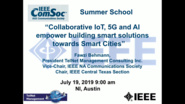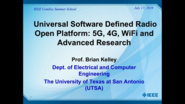
- IEEE MemberUS $4.99
- Society MemberUS $0.00
- IEEE Student MemberUS $4.99
- Non-IEEE MemberUS $9.99
Collaborative IoT, 5G and AI empower building smart solutions towards Smart Cities
From the 2019 IEEE ComSoc Summer School at National Instruments, Austin, TX, USA, Fawzi Behman, Chairman, IEEE Communications and Signal Processing Combined Chapters, discusses how the emergence of autonomous driving is bringing communication and mobility closer together. Health and wellness is moving from clinical settings into homes, cars, and other places. As the boundaries between these areas continue to be traversed, the value of data is bringing the need for near ubiquitous sensing, data collection, and artificial intelligence?in the cloud and at the edge?into virtually every area of our customers? lives. The IoT is trying to solve problems across those segments, and that is driving a change in how players in the IoT space need to think and operate. Sensing is becoming increasingly multimodal and media-driven. Real-time insights are required to support decision-control loops that operate in microsecond to millisecond timescales for mission-critical industrial control and processing. Edge intelligence and low-latency quality of service will support the next generation of immersive user experiences. This summit will also discuss how moving computation to the edge helps to increase data privacy & security for user/enterprise and diverse geographies. The ushering of powerful communication standards such as 5G not only delivers the speed, mass connectivity and real-time ? low latency mission critical applications. With the advent of Artificial Intelligence (AI) and Machine Learning (ML), real-time data-analytics can be performed on the data to provide predictive and preventive analytics for smart connected things in the connected world. The talk focuses on three principal applications/use cases; namely Smart Healthcare, Smart Mobility and Autonomous Vehicles, and Smart Cities.
- IEEE MemberUS $4.99
- Society MemberUS $0.00
- IEEE Student MemberUS $4.99
- Non-IEEE MemberUS $9.99
Unlocking efficiencies in supply chain & distribution using Industrial IoT
From the 2019 IEEE ComSoc Summer School at National Instruments, Austin, TX, USA, Dr. NR Viajy, Adviser, Digital Automation & Cloud, Prolifics, discusses how in an integrated world, retailers looking to serve eCommerce consumers have to deal with high expectations - ?Free one day shipping?, high quality products delivered at low cost while keeping the consumers updated on order status. Mastery of supply chain and distribution translates to maximum market share and associated margins. Hence, it is necessary for retailers to source high quality products from low cost places anywhere in the world. It?s also critical to ensure product quality along the supply chain. Onshore, optimizing last mile delivery is a key differentiator. Industrial IoT promises to unlock efficiencies in both supply chain and last mile delivery.
- IEEE MemberUS $4.99
- Society MemberUS $0.00
- IEEE Student MemberUS $4.99
- Non-IEEE MemberUS $9.99
Leveraging Machine Learning in the Wireless Physical Layer
From the 2019 IEEE ComSoc Summer School at National Instruments, Austin, TX, USA, Tim O'Shea,Chief Technology Officer, Deepsig, discusses how machine learning has recently seen a number of enormous advances in both computational, algorithmic, and data-driven capabilities. Over the past few years dramatic breakthroughs have been realized in computer vision, natural language processing, and a wide range of other applications. This data driven approach promises as well to drastically transform how we do wireless signal processing in the physical layer, scaling systems from idealized analytic models to incredibly detailed complex data-driven models which work better in the real world, and driving down computational complexity by moving to highly concurrent and compact inference engines. This talk will discuss the key trends and enablers for deep learning and data driven system design, and then it will deep dive into several key applications within wireless physical layer sensing and communications system design, detailing how these approaches can be leveraged and applied, and illustrating key recent works and results which highlight performance advantages of leveraging data driven signal processing and neural network style inference engines for a range of tasks where they can outperform traditional idealized analytic models.
- IEEE MemberUS $4.99
- Society MemberUS $0.00
- IEEE Student MemberUS $4.99
- Non-IEEE MemberUS $9.99
Using FPGAs and SDRs to create real-time testbeds
From the 2019 IEEE ComSoc Summer School at National Instruments, Austin, TX, USA, Sarah Yost, Senior Product Marketing Manager for National Instruments, discusses how in today's wireless communications world, being able to create real-time testbeds to prototype new ideas and algorithms is a critical step in advancing new technologies. The newest communications standards have even tighter timing constraints and larger bandwidths than previous generations and host-based processing no longer sufficient to create prototypes that need a real-time physical layer. This session will dive into some of the hardware and software tools that are available to create testbeds as well as discuss some examples of successful testbeds.
- IEEE MemberUS $4.99
- Society MemberUS $0.00
- IEEE Student MemberUS $4.99
- Non-IEEE MemberUS $9.99
Deep Learning Based Security Solutions for the Internet of Medical Things
From the 2019 IEEE ComSoc Summer School at National Instruments, Austin, TX, USA, Heena Rathore, Data Scientist and Program Manager, Hiller Measurements discusses how intelligent healthcare has gained importance in the recent past since it allows continuous, remote monitoring of patients away from hospitals and doctors. With advances in technology, doctors now can improve quality of medical service for their patients through a surgical methodology that includes implantable embedded medical devices. Addition of connectivity to such devices is the key enabling technology. Devices are now connected to each other and to the world wide web (internet), which leads to the use of the term Internet of Medical Things. To enable this, medical devices now have WiFi/Cellular chips on them so that they can talk to each other, in addition to the traditional roles of sensing and actuating. However, on the other end, addition of connectivity and computing platform now makes these devices more prone to hacking. This talk focuses on how deep learning techniques can be utilized to make these devices secure. This talk covers different problems of security ranging between internal to communication attacks such as authentication, classification, prediction on implantable medical devices such as insulin pump implants, deep brain stimulators and cardiac defibrillator. Thi talk will cover efficient techniques, such as multi-layer perceptron neural networks, recurrent neural networks, etc. to overcome these problems. This talk also discusses how these algorithms can be implemented on the node or on the edge to enable real-time decision making.After this lecture, audience will be able to apply deep learning techniques to make medical devices secure from unauthorized access. They will learn the tools to compare different types of techniques and also a working understanding of how to implement such algorithms on embedded processors.
- IEEE MemberUS $4.99
- Society MemberUS $0.00
- IEEE Student MemberUS $4.99
- Non-IEEE MemberUS $9.99
360° and 4K Video Streaming for Mobile Devices
From the 2019 IEEE ComSoc Summer School at National Instruments, Austin, TX, USA, Lili Qiu, Professor, University of Austin, Texas discusses high level video applications and how they utilize network resources. Video streaming is extremely popular and accounts for 58% of internet trafic worldwide, with users demanding high resolution vidoe streaming of 360 degree and 4k videos. This puts tremendous stress on the network and the network thus faces numerous challenges in usability.
- IEEE MemberUS $4.99
- Society MemberUS $0.00
- IEEE Student MemberUS $4.99
- Non-IEEE MemberUS $9.99
Software Defined Radio Adaptive Arrays
"From the 2019 IEEE ComSoc Summer School at National Instruments, Austin, TX, USA, Payam Nayeri, Assistant Professor, Colorado School of Mines, discusses how digital beamforming (DBF) is the platform for smart antenna technology, and with the rapid growth of our wireless infrastructure, DBF is considered a major necessity for 5G and beyond. Adaptive algorithms coupled with these arrays enable automatic rejection of interference and can maximize the communication throughput in any dynamic environment. In general, the challenge is that hardware implementation is very high cost, and as a result very few practical implementations of digital beamformers have been reported. We propose an implementation of DBF arrays using software defined radios (SDRs). The SDR platform is a versatile, low cost solution to DBF and at the same time provides a practical testbed for rapid testing of different beamforming algorithms. In this talk, we outline the process of hardware implementation, synchronization, and calibration of our in-house, low-cost, digital beamformer that uses an array of NI USRP SDRs, and then present experimental results for DBF using classic techniques such as LMS, RLS, and SMI. We then extend this discussion to high-interference scenarios and show that classical approaches to DBF often cannot distinguish between the intended signal and interferences, disrupting the intended operation. We then present a novel beamforming methodology based on evolutionary search techniques that is capable of adaptive interference cancellation in high-interference environments. We present experimental results on the performance of our proposed technique using our in-house developed digital beamformer and show that our system is capable of complete interference cancellation in several high interference scenarios.
- IEEE MemberUS $4.99
- Society MemberUS $0.00
- IEEE Student MemberUS $4.99
- Non-IEEE MemberUS $9.99
Universal Software Defined Radio Open Platform: 5G, 4G, WiFi and Advanced Research
From the 2019 IEEE ComSoc Summer School at National Instruments, Austin, TX, USA, Dr. Brian Kelly, Professor, University of Texas San Antonio discusses a Universal Software Defined Radio Open Platform capable of reconfiguration in real time and support for all major wireless access technologies. This includes all smart antenna modes of 5G (5G-NR sub-6 GHz), its predecessor 4G.
- IEEE MemberUS $4.99
- Society MemberUS $0.00
- IEEE Student MemberUS $4.99
- Non-IEEE MemberUS $9.99
Evolving 5G and Challenges Ahead - 5G 2.0
From the 2019 IEEE ComSoc Summer School at National Instruments, Austin, TX, USA, James Kimery, Director of Marketing, Advanced Wireless Research at National Instruments discusses 5G from design to prototyping to testing.
- IEEE MemberUS $4.99
- Society MemberUS $0.00
- IEEE Student MemberUS $4.99
- Non-IEEE MemberUS $9.99
5G NR Air Interface: An Overview
From the 2019 IEEE ComSoc Summer School at National Instruments, Austin, TX, USA, Ian Wong, Senior Group Manager Advanced Wireless Research, National Instruments will host the group touring the National Instruments 5G Research Lab to see some of the latest technology such as a beam forming mmWave technology and advanced computational prototypes around 5G.
- IEEE MemberUS $4.99
- Society MemberUS $0.00
- IEEE Student MemberUS $4.99
- Non-IEEE MemberUS $9.99
My Ten Favorite USRP Experiments and Implementation of Overlay Cognitive Radios
From the 2019 IEEE ComSoc Summer School at National Instruments, Austin, TX, USA, Prof. Murat Torlak of the University of Texas at Dallas, shares his own experiences primarily teaching with USRPs and he then discusses how he plans to use USRPs in research projects sponsored by the National Science Foundation.
- IEEE MemberUS $4.99
- Society MemberUS $0.00
- IEEE Student MemberUS $4.99
- Non-IEEE MemberUS $9.99
RF and Microwave System Design
From the 2019 IEEE ComSoc Summer School at National Instruments, Austin, TX, USA, Erik Luther, VP of Sales and Marketing, xMicrowave, discusses that as wireless communications designers we often abstract away many of the real-world hardware aspects of the wireless system so that we can focus on just one layer of the stack. However, these aspects of the system are increasingly important as the industry.
- IEEE MemberUS $4.99
- Society MemberUS $0.00
- IEEE Student MemberUS $4.99
- Non-IEEE MemberUS $9.99
Digital and hardware solutions to mitigate the high PAPR problem of OFDM signals signals in RF power amplifiers
From the 2019 IEEE ComSoc Summer School at National Instruments, Austin, TX, USA, Dr. Tommaso Cappello, Rsearch Associate, UC Boulder, discusses digital and hardware techniques to mitigate the high peak-to-average-ratio (PAPR) problem in wideband OFDM signals (5G). The high-PAPR problem can be mitiagated through digital baseband techniques such as digital pre-distortion (DPD), crest factor reductio, and mixed approaches. However, due to the demanding requirements in both high PAPR and bandwidth in 5G systems, a mixed combination of digital and analog techniques is key in order to achieve efficient amplification of such signals. To this aim, envelope tracking, outphasing and the recently introduced load-modulated balanced amplifier provides possible benefits with such signals. In this talk, amplifier topologies and digital solutions are compared theoretically and experimentally by using NI hardware and software platforms.
 Cart
Cart Create Account
Create Account Sign In
Sign In












